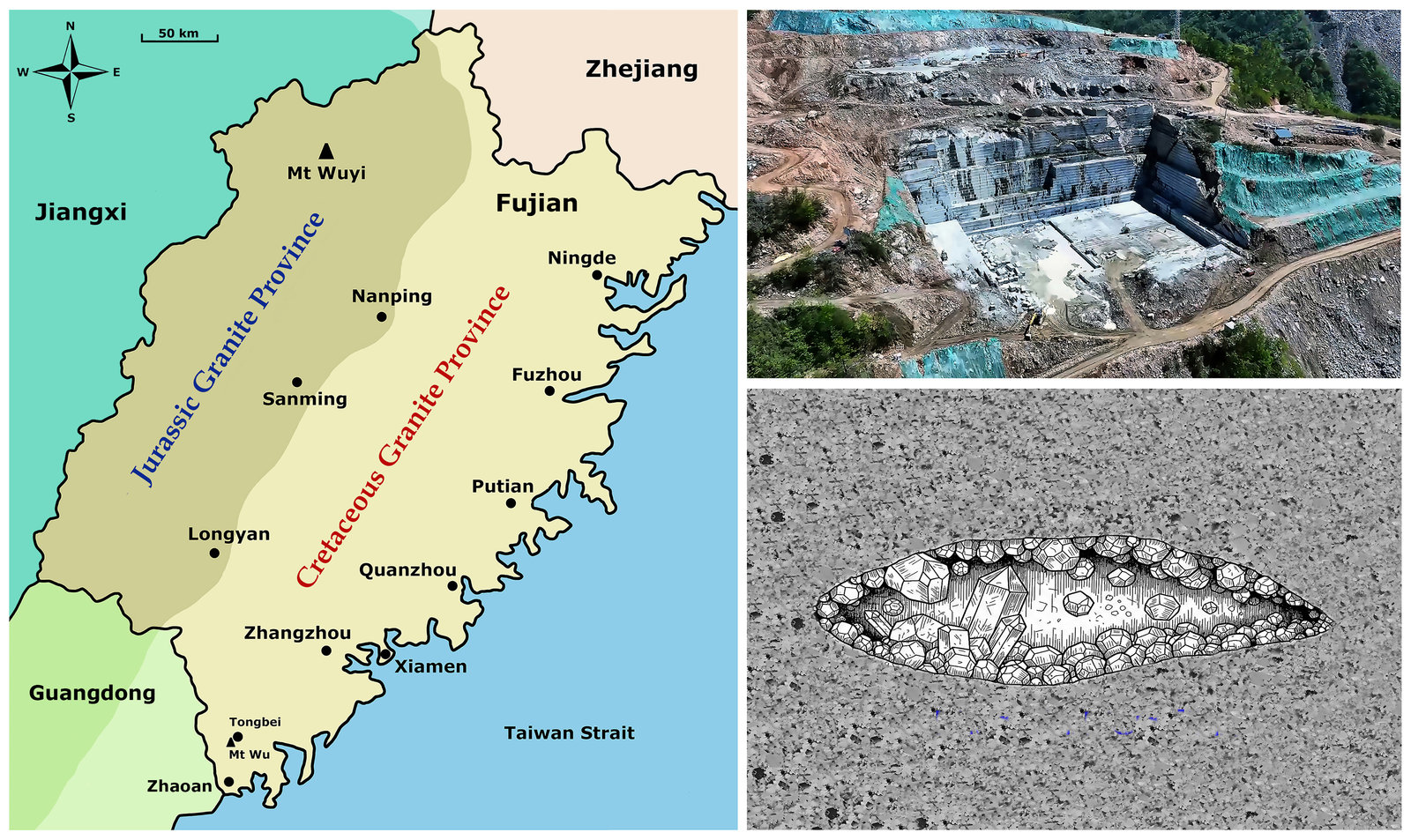Mineral: Spessartine and Smoky Quartz
Locality: Wushan Spessartine prospects, Tongbei, Yunxiao, Zhangzhou Prefecture, Fujian Province, China
Description: Photo 1 - Map, Quarry and Cavity
The diagram provides a geological overview of Fujian Province (Map by Silvia). In the upper-left, a map situates the province on China's southeastern coast and uses shading to delineate its two principal igneous zones: one Jurassic and the other Cretaceous in age. This broad classification reflects the dominant age of the granitic intrusions in each zone, not specific local geology. The upper-right features a photograph of a typical commercial Fujian granite quarry (Photo courtesy of Chao Li), below which is an illustration of a mineral-bearing miarolitic cavity (Diagram by Silvia).
Discussion
Spanning 800 kilometers along China's southeastern coast, the Cretaceous-age granitic belt in the provinces of Guangdong, Fujian, and Zhejiang is a world-renowned source of exceptional mineral specimens. This geological feature resulted from the Mesozoic-era subduction of the Paleo-Pacific plate beneath Eurasia, which generated vast quantities of magma that cooled slowly within the crust to form extensive granitic plutons.
Miarolitic Cavity Formation
A defining feature of this granitic province is the abundance of miarolitic cavities — crystal lined vugs that formed during the final stages of magma crystallization. As the silicate melt solidified, volatile components like water, fluorine, and boron, along with certain “incompatible” elements, become concentrated in the residual fluid. When the fluid reached saturation, a state often triggered by a decrease in lithostatic pressure from the overlying rock, it exsolved (separated) from the melt, creating open pockets within the largely solidified granite. This superheated, volatile-rich fluid provided an ideal medium for crystal growth. Its low viscosity and high ionic mobility facilitated the efficient transport of chemical constituents to nucleation sites, allowing for the formation of large and perfectly formed (euhedral) crystals.
Geochemistry and Spessartine Genesis
Miarolitic cavities are of significant petrological interest because they concentrate elements that are incompatible with the crystal lattices of common rock-forming minerals like Quartz and Feldspar. Elements such as Manganese (Mn), Beryllium (Be), and Lithium (Li) are preferentially partitioned into the final magmatic-hydrothermal fluid.
The formation of the region's famous Spessartine Garnets is a direct result of this process. The parental magma was inherently rich in Manganese, likely derived from the partial melting of Manganese-bearing meta-sedimentary rocks. As an incompatible element, Mn was concentrated in the fluid that filled the miarolitic cavities. Within this stable environment, slow cooling allowed the fluid to become supersaturated, leading to the methodical precipitation of gem-quality Spessartine crystals.
Mineral Assemblages and Characteristics
The Spessartine specimens from this belt, particularly those from Fujian province, are celebrated for their vibrant “Fanta” orange color, exceptional transparency, and razor-sharp crystal forms. A third of the significant mineral localities in the belt are famous for producing these garnets.
These brilliant orange crystals are often found in magnificent assemblages, perched aesthetically on a matrix of milky or smoky Quartz. They are frequently accompanied by lustrous blades of Feldspar (typically Microcline) and occasionally Schorl tourmaline or Topaz. This specific mineral association, such as Spessartine with smoky Quartz found in Fujian’s granite plutons, provides geologists with a direct sample of the late-stage fluid, indicating conditions of high Manganese and silica concentration and relatively high oxygen fugacity.


All pictures, text, design © Forum FMF 2006-2025


